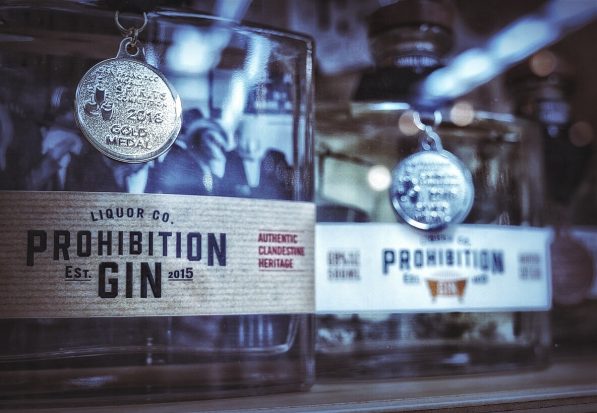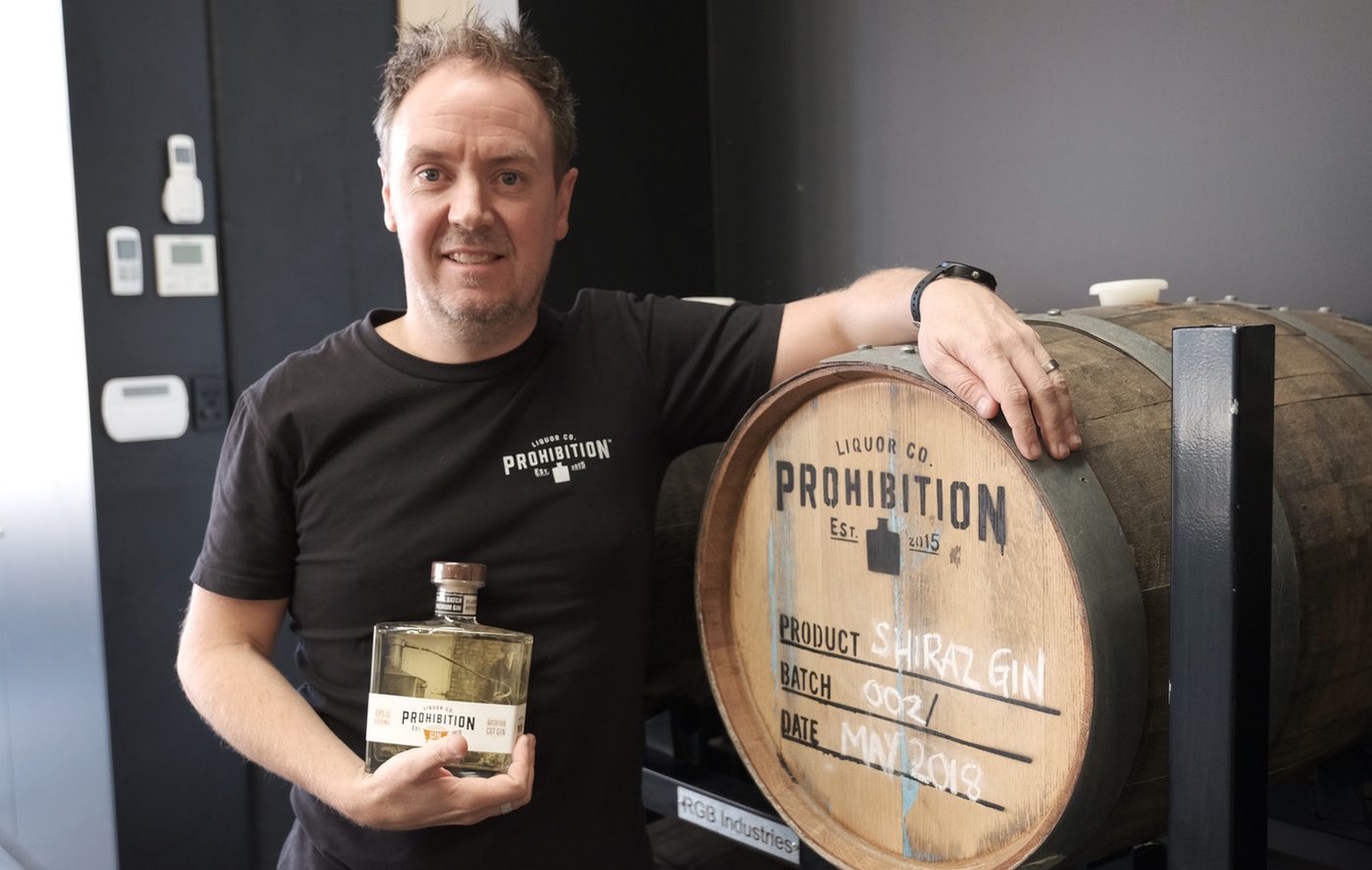With so many Gins around, we talk to Adam Carpenter, from Australian Gin brand Prohibition Liquor Co, about their Bathtub Gin expression.
We ask Carpenter to explain an overproof Gin, why it was created and in what cocktails it can be used.
Additionally, we discuss Gin in South Australia, whether Australian Gin should be a category and whether consumers should buy spirits based on their awards.
[00:01:23] – What was the Adelaide scene like in those days?
[00:02:20] – And the one you were developing with Applewood?
[00:03:29] – When you talk about having punchy flavours, what botanicals are you including?
[00:06:07] – How difficult was it for you to decide what botanicals to use?
[00:08:56] – What cocktails did you envisage for your bathtub?
[00:11:40] – If you are at home and you are not really a gin drinker or you haven’t really experienced a lot of gin, is this a gin to start on?
[00:12:42] – Would you say people should almost halve the amount of gin they would normally put in something when they first approach it?
[00:13:34] – You have recently opened this wonderful café/bar area in the middle of Adelaide, are you finding that they approach it differently than you thought they might.
[00:15:14] – So if you were taking your gin, specifically the Bathtub Gin, home for the first time, what would be the first thing you would make with it?
[00:16:51] – With star anise as a major flavour coming through and the citrus that you were talking about, what other flavours will your Bathtub Gin work well with?
[00:18:18] – So what is the future for Prohibition?
[00:19:59] – As you explore more of the natural botanicals do you believe that Australian gin needs its own classification?
[00:21:09] – How important do you think awards are or should they be to consumers in determining what they buy?
[00:23:06] – Thank you
Can you give us a little bit of history of Prohibition
We started Prohibition in 2015, Wes, my business partner, and I both have busy full-time jobs but we decided we wanted to start a project of some sort and when Wes mentioned gin which was a bit of a homage to his recently passed step-mum it sounded like a bit of fun and also something we could really sink our teeth into.
What was the Adelaide scene like in those days?
It was pretty early in the Adelaide scene. I think we were about the fourth or fifth brand into the market. We started in early 2015 talking about it, we then had some very fortuitous catches with Brendan and Laura Carter from Sapwood distillery and we worked out that we could work with them in a very creative way to bring a new brand to market quite quickly and using their expertise and I guess our brief and our creative vision of what we wanted to create. So we were about the fifth brand to market and now there are 32 as of this week in the South Australian market and that’s really since we launched in December 2015. It’s really boomed since then.
And the one you were developing with Applewood?
The first gin we created was our original gin, so 42% delicate contemporary take on a London dry and what we were setting out to do was what we felt was missing from the market which was the perfect martini gin. So we created that as our first spirit and it’s still probably our biggest selling spirit because it is the most approachable. We felt after releasing that there was another hole in the market for something that was incredibly pushy, much more traditional in terms of that juniper forwardness but what is essentially then the perfect cocktail gin. So we had the perfect martini gin but it is quite delicate. To create the perfect cocktail gin we needed something at the complete opposite end of the spectrum so a really punchy flavour and high alcohol content in this case. It was the guys at Applewood again that we went back to and said our next brief is completely different to the last one. Let’s go as hard as we can with something really intense and that was again a really interesting creative journey.
When you talk about having punchy flavours, what botanicals are you including?
We had a goal for ourselves to create an overproof, a bit like what sort of drives us in business. If we are going to do something we are going to do it to the maximum of our capacity so we decided if we were going to make an overproof we were going to make the strongest overproof Australia has ever seen and that’s where we settled on 69%. It was a happy accident that 69% ended up, at 1% higher it is actually officially a dangerous liquid so by sheer fluke we settled in at the highest percentage that you actually could do which we found out afterwards. What we had to do though, it was a real exercise in chemistry to make that 69% neat drinkable because all of our spirits are primarily about neat drinking so to make 69% neat drinkable needed a lot of intensity, yes of juniper, but more so of intense flavour that was going to offset that. So we’ve got a big hit of star anise up front, I often liken it to drinking an Absinth or even an ouzo first up, this big hit of star anise that your pallet is trying to make sense of over a big alcohol content. We then followed that up with this beautiful warmth of cinnamon from cassia bark. So you have got a secondary maceration of juniper in the spirit as well so it’s quite noticeably a golden colour and that golden colour comes out of that secondary maceration post distillation of the juniper. So it is definitely juniper forward, basically everything has to be dialled up to 11 to sit against that 69% alcohol. Big oil content as well, things like almonds and a lot of oil coming out of the vanilla. So again everything that is in this gin is there for a strong reason around offsetting that alcohol content but making something that can be still balanced, neat drinkable and really unique in flavour. So again a couple of hits of citrus, but more intense citrus so grapefruit rather than ruby grapefruit which we had used previously and a traditional orange rather than blood and so again looking at that intensity of that flavour set to sit against that very bold gin.
How difficult was it for you to decide what botanicals to use?
There are a couple of core botanicals that make a signature of all of our gins. We always use vanilla for the sweetness and softness; we always use lavender on the finish; we always use green tea to settle down the middle body of the spirit. So there were a couple of core components that we wanted to retain. We knew we needed more intensity out of the citrus which is why that change of flavour but again a lot of it was that function of alcohol content. So what are you going to get strong flavour from that is going to kick it above that alcohol content and it really was that star anise. But then the other ingredients, like I said the addition of the almonds was purely to get an oil content that was going to allow that spirit to have a long round mouth feel rather than evaporating instantaneously which 69% should do. Everything else really is quite restrained in that gin so it’s those core ingredients that shine through. Our root ingredient was ginger yet again but again dialling up that ginger so it had a bit of heat to it. I think it was very much how are we going to take intense flavour and intense alcohol content but still make it taste like a prohibition gin at that finish. So as soon as you add tonic for example all of that intensity dials back and a lot of our signatures of our gin push forward so you get that floral note pushing forward. You get the citrus forwardness pushing forward and a lot of that intensity drops away very quickly and that’s what really surprises people when we do tastings at gin festivals.
And I assume the name comes through the intensity of the bathtub
So the name was a couple of points I guess. Bathtub Gin was obviously a prohibition term for gins that were made often at home. They weren’t distilled in a bathtub because you can’t distil in a bathtub so it was a bit of a misnomer, but the bathtub always had a place. It was generally the only place in the house where you could get a vessel big enough full of spirit to water it down to bring it down to drinking percentage. But for us it was also that bathtub notion of that secondary maceration of the juniper so we were soaking it in a bathtub of spirit and then very much that homage to bathtub gin at the time but a lot more refinement for a modern audience.
What cocktails did you envisage for your bathtub?
It’s interesting, we knew we were making a cocktail gin, we didn’t know what it was going to play best to until we started really exploring it once we had made the spirit. So the first thing that shocked me when we first tasted it and got it right was how approachable it actually is given its percentage. But it was when we started exploring things like an Agroni we really didn’t know how that was going to go. We knew we wanted to have a good crack at an all Australian Agroni so a really good chat with Brendan from Applewood in highlighting the ochre as the Amaro and then finding the right vermouth to match with it so the guys from Aidini make us a special batch of unfiltered sweet vermouth these days which we work with; really meaty and earthy. The interesting thing is the bathtub gin becomes the let’s call it the rug that ties the room together where it plays against those other two very rich ingredients but it makes still a gin forward Negroni which is not generally what the gin is there for. But what it does is it ties together all those other ingredients, bringing I guess all the work we put into making it drink neat has softened down a lot of that intense bitterness that you expect from a Negroni but what you get is this intense length and breadth of flavour. So you have got this quite balanced but very rich experience in our all Australian Negroni. But then moving from there it is I guess because of the nature of that intense flavour and alcohol content it is essentially the perfect cocktail gin. So you have got a gin sour becomes gin forward, even I guess your most flavoursome prohibition era cocktails which were there to mask the gin, the gin still punches through which is great. So we have got a bunch of different expressions that we do everything from a corpse reviver is going to be very gin forward again and that support of that strong anise works well but essentially we find that bartenders love it because they are not pouring something that is 69% alcohol, you are not actually you know a standard measure is going to punch through anything but also there are bars around Australia that actually use this gin in a signature cocktail because it doesn’t hold back, it doesn’t take any prisoners but it is really quite a unique spirit.
If you are at home and you are not really a gin drinker or you haven’t really experienced a lot of gin, is this a gin to start on?
I often have a slightly scared moment when someone says I have bought a bottle of your gin, I bought the bathtub because it looked like it was the top shelf and I said OK just tread carefully. It is intense, it is unashamedly intense. The funny thing is though when you serve it as a gin and tonic, so use a good tonic but it is so robust it will sit against any tonic really, but something like Strangelove Dirty Tonic or even a more traditional Indian tonic it’s going to punch through. We garnish it with star anise again and the cassia bark and you get that beautiful support of those two core botanicals, a really earthy gin and tonic but even the least seasoned campaigners are going to find it very easy to drink. It is actually a little bit scary.
Would you say people should almost halve the amount of gin they would normally put in something when they first approach it?
Anything like this is to personal taste essentially. If you mix this as a traditional gin and tonic mix, whether it be your 2 to 1, or 3 to 1, it’s actually really friendly so you actually find yourself not having short pour but you can if you feel the need. I think what we actually have most trouble convincing people is not to be scared of it in the first instance because they generally try it and say oh I didn’t expect it at 69% to be that friendly.
You have recently opened this wonderful café/bar area in the middle of Adelaide, are you finding that they approach it differently than you thought they might.
I think taking a step back from that I think the thing that has surprised me most about what we enjoy about what we do now is the bringing joy to people is the one part of making gin that I didn’t expect to be so enjoyable for us. So being able to share that experience with people is I think the thing that we really love and what this place is about is all about education. So it’s a chance for us to either take someone who has never had gin in their life and give them a level of knowledge that they can walk away from here and more or less know what they are doing with gin at home or how to pick the right gin and mix at a bar but also I think we can convert a few people from some of their misheld assumptions about gin, whether it be how they are serving it at home or whether it be what tonic they are using, just fighting the good fight about that quality story. But we also have 100 gins on our back bar so it’s not just our product that they might learn something about so we are always showcasing craft spirit from around Australia to essentially show we have got an industry that is world class which is pretty exciting.
So if you were taking your gin, specifically the Bathtub Gin, home for the first time, what would be the first thing you would make with it?
I think being able to make a good gin and tonic because its quick, easy, fresh and friendly and not taking anything too seriously for the general punter, I think just getting that mix right, using a good quality tonic and exploring some of those garnishes that will work well with that gin for a G&T is a really good starting point. But we try and I guess convince people to not be afraid of making something like a gin sour at home. I mean it seems very complex lentil you actually highlight that the ingredients are not that difficult, its stuff that generally people have at home. They have got some lemons lying around for example and they have got a couple of eggs that they can take some whites out of, with a little bit of process with the shaking to get that right it’s really not a difficult thing to do. But its things that people are often a little bit scared of until you break those barriers down. But I think start with a G&T, we pre-bottle a Negroni these days just to make that easy for people but we always use that same mix and then I think it’s really the fun of gin is being able to explore different things. There are lots of expressions that would point people in the direction of but we generally try and gauge what they like first and send them away with some options.
With star anise as a major flavour coming through and the citrus that you were talking about, what other flavours will your Bathtub Gin work well with?
A good question, star anise is an interesting ingredient. It can be quite divisive if someone has had a bad experience on Absinth or Sambuca for example they might have a little bit of trouble coming at it first up but you can settle down that star anise quite quickly with citrus for example. I mentioned the sour mixer, a south side for example you generally lose the gin because you have got that intensity of citrus but again you are going to get that punch through of the anise and the warmth of cinnamon which is nice. So citrus is a good one to sit off against it, just something as simple as garnishing with mint for example will kill off a lot of that intensity that may scare people with the star anise. So mint garnishes are not for every gin because they will overplay a lot of things but a robust gin can take it so I think some of your more herbaceous garnishes are going to offset that aniseed edge.
So what is the future for Prohibition?
We have finally installed a still here in Gilbert Street which has been a long time coming. It was a function of having enough space because we ran out of space the moment we moved in which was a good problem to have. We finally have Mary, our 900 litre beautiful copper still up and running so that gives us the flexibility to make a whole bunch of new and interesting things. We really want to explore Australian native botanicals further because I think it is so important for the Australian gin industry to explore what we have in this country but also we will make some whiskey one day but it may not ever sit under Prohibition as a brand. I think for us it’s about extending the experience that people have here doing gin blending masterclasses for example where you come away with your own gin expression and really I guess making a bit more product so we can hit the export market, that’s I guess where Australian gin needs to be kicking goals more so it’s getting it beyond Australian lips. So we will always be making sure that the local market is well and truly well cared for and getting as many people through this door to educate and fight the good fight for craft gins but then we have got a lot of capacity for production now on growth which we haven’t had so it’s really exciting for us for the next few years.
As you explore more of the natural botanicals do you believe that Australian gin needs its own classification?
Mmm that’s an interesting question. Look I think we do a lot beyond the traditional London Dry and I think we all know that. It’s interesting, we really grapple with our gins, even how you enter them in spirit competitions, are we a London Dry on the contemporary edge or are we truly a contemporary gin and it depends on the competition as to how different judges might see that. I think Australian gin is taking it to the world, whether it means that we end up with our own classification I think it would be a great thing but I think if nothing else we are doing really interesting things with the very dry and staid traditional London Dry category. I think we are already doing it, whether we need the classification I think we will succeed either way.
How important do you think awards are or should they be to consumers in determining what they buy?
The awards are a really tricky question. For us they are a blessing and a curse. They are a blessing in the fact that touch wood which I am doing right now, we have won an award for every entry we have ever put a spirit into and that’s now getting close to 50 individual awards so that is a 100% hit rate from 50 entries. But it is an expensive exercise so that as a business is tricky, particularly when you are trying to move your spirit around the world and all the joys that go with trying to ship into the US for example. As a consumer though once someone has tried our gin we know they will come back but getting that first sale what does the consumer have to go on. So awards is just one of those things that I guess can help them see this product has had recognition from XYZ awards around the world which gives me some degree of confidence that there is something good going on here. But bear in mind that everything with awards is completely subjective and we find that with the results we get across the world. The same spirit entered in 5 different competitions doesn’t get the same result so you do have to take the whole thing with a pinch of salt, it is subjective but we keep entering because we feel it’s of value and it helps reinforce if nothing else with the Australian consumer that we are making objectively judged world class spirit.
Thank you Adam









